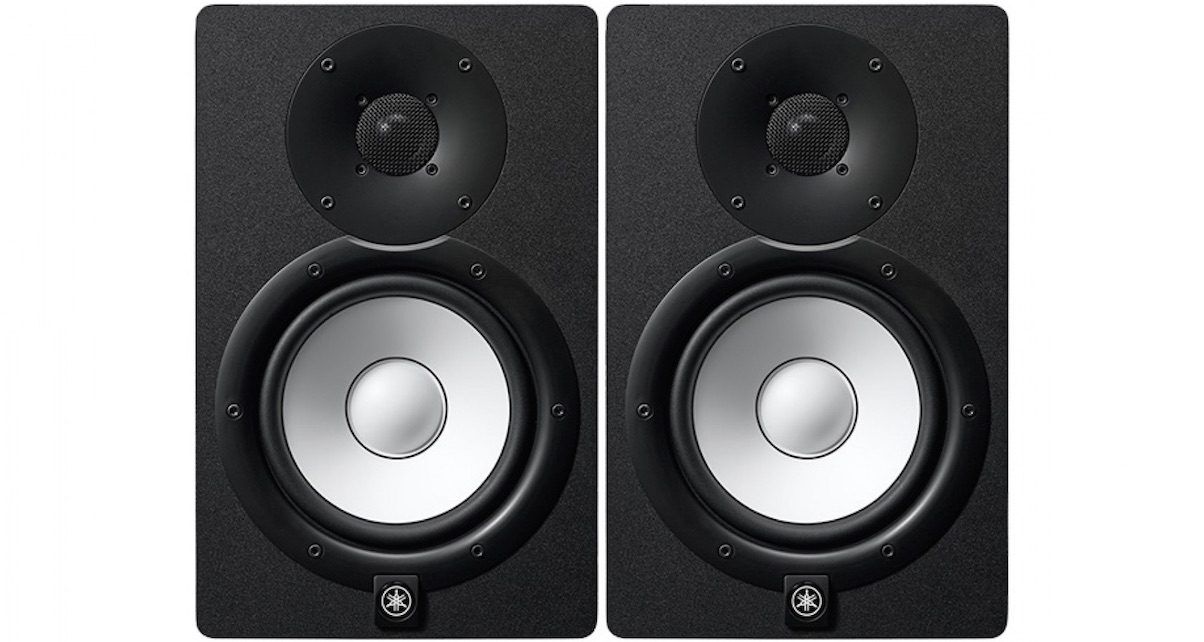The Lowdown
Clear, true sound, deep enough bass to mean no subwoofer required in most circumstances, and realistically priced for any ambitious DJ / producer, we can find nothing to fault on the Yamaha HS7s. Highly recommended.
Video Review
First Impressions / Setting up
They’re a mid-sized black speaker made in MDF, with the now-iconic Yamaha white woofer cone and grilled tweeter (think NS10, the near-legendary small studio monitors). With a 6.5″ cone, they’re appreciably smaller than the HS8s, and this might actually be the perfect size for DJ/producers, as we’ll get on to. They are rear-ported (hole in the back to improve the bass), and are pretty standard as far as controls go: 1/4″ and XLR inputs, volume, on/off, and three-way attenuator switches for fine-tuning bass and treble (simply to suit where you’ve placed them in your room). There are large cooling fins on the back. They have 95W of output per speaker. Overall, they feel good quality, reassuringly heavy (over 8kg each), and look smart and workmanlike.
They’re “proper”, sold separately, individual monitors, and don’t function as a pair in any way, like some speakers aimed at the home studio. So no linking them together or wired remote controls here: you have a mono input per speaker (left output from DJ controller or mixer to left-hand speaker, right output to right-hand speaker) and turn them off/on and adjust their volumes totally separately. If you’re new to all of this, this is how “real” studio monitors traditionally have worked, and how most still do, especially as you move up the price range where performance matters more than consumer-friendly features.
In Use
I was lucky enough to use these over an extended period of time, as my speakers of choice when producing a Traktor Kontrol S8 tutorial series. It was quite a good test for them, because while the Traktor Kontrol S8 is a DJ software controller first and foremost (and I played MP3s, WAVs and AACs through the Yamahas via that route, mainly EDM), it is also a standalone mixer, and I used it to play music from vinyl and CD, and non-EDM too. Therefore I’ve tested the speakers from a DJ’s point of view, but also auditioned how full vocals and acoustic instruments sound through them, too.
Firstly, let’s be clear: they’re monitor speakers designed for production use. They’re from Yamaha, a company with real pedigree in this area. And overall, they sound excellent. Bass deep enough that you really don’t need a separate subwoofer (which is a great thing in my view as subwoofers can complicate the sound as well as improve it). They give an overall sound that’s true to the original, giving the confidence that if you’re producing on them, you’ll be able to mix down and be reasonably sure your results are going to sound good from earbuds to nightclub.
Over time, I spotted some characteristics, subtleties that I want to report here. I found the mids to be not as accentuated as some speakers, especially those aimed at DJs, and so they didn’t have the exact same bright “thump” on high bass and low mid percussion, for instance. I actually believe this to be a truer reflection of the source material, something I decided having listened at length to both EDM and non-EDM on them, and thus a very good thing.
This better overall balance wasn’t at the expense of them being engaging or fun to listen to (trust me, turned up they truly pack a punch), but it did mean that not only did non-EDM fare better on them than it does on some speakers, but that they were easy to listen to over a long period of time. Worth pointing out that they sounded noticeably different to my memory of the long-discontinued but legendary (they were in the first studio I ever recorded in) NS10s from Yamaha, that I recall being harsher in the mids.
Of course, there’s no need to talk about interference or distortion at higher volumes or any of those other considerations when listening to, say, sub-$100 speakers, as the HS7s had an audibly great signal-to-noise ratio and we couldn’t get them anywhere near loud enough to introduce any kind of harshness to the sound. They handle DJ/producer studio monitoring tasks in mid-sized rooms very comfortably, with plenty of headroom to spare.
Conclusion
Overall, they’re great. They hit what I reckon will be a real “sweet spot” for many DJ/producers. Firstly, the sound is true, truer than more coloured-sounding monitors aimed explicitly at DJs. As I’ve described, even for pure EDM DJs, I think this is a good thing, especially if you want to start producing. Secondly, they are just the right size for maybe the majority of home studios: Designed to be used near-field and in mid-sized rooms (just keep ’em away from the walls if you can), they are big enough to pack enough bass punch to negate the need for a sub-woofer (a good thing), but still small enough to be practical.
If you’re sold on the idea of “real” powered monitors, wired up separately without the bells and whistles of linked, remote controlled speakers (as sold by some DJ companies into this market), these should be on your list. I’m not going to pretend to give you like-for-like comparisons to other brands, because we would need to run such a test side-by-side and we have no other loan samples here to do that with at present, but if I say that we truly don’t want to send them back, you’ll get a sense of how much we’ve grown to like the HS7s.
Test them in person if you can against your other shortlisted items, but overall, at this price level, we think they’re more than a sound choice for ambitious DJ/producers looking to upgrade their home studios to professional sound.


